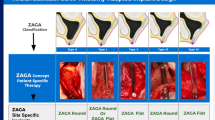Abstract
This study aimed to demonstrate that during an open frontal lift, transection of the galea is not necessary. The forehead is elevated, and the ptotic brow is raised after a strip of skin or scalp is removed by folding of the galea. The marcation is penciled on the skin according to the amount of skin–scalp the surgeon estimates it is necessary to remove. Local anesthesia is profusely injected, separating all layers and facilitating surgery. The skin is stripped off the galea, and then through a small incision in the middle, a large dissector separates the galea from the periosteum of the forehead and temporal regions. This dissection can be completed from the temporal area or from the blepharoplasty incisions. With a long pair of scissors, the orbital borders are reached and opened perpendicularly to the bone, releasing the fascia and muscle attachments from the orbital rim without anything being cut. During the coronal approach, once the scalp and forehead are completely mobile, the galea is folded with a continuous running 3/0 Vicryl suture, which after five or six big bites is strongly pulled to fold the galea. The wound then is sutured without tension using staples. When the incision is precapillary, the folding is fixed with Vicryl 3/0 uncolored thread, and the skin is sutured with mononylon 6/0. Complementary corrugator transections are performed from the blepharoplasty incision or by use of the endoscope. With the coronal approach, the surgery requires about 20 min, whereas the precapillary approach requires about 40 min. When only the skin is removed, bleeding is scarce and frontal postoperative edema is minimal. The author has used these techniques in 22 precapillary cases and the intracapillary procedure in 28 cases, some of which had a 4-year follow-up period. With the precapillary approach, temporary paresthesia occurred in some cases, but in all cases, sensibility was recovered within the first 2 to 6 months. With this simple and brief technique, the galea is not transected, no branches of the sensitive nerves are sectioned, and temporal and frontal arteries and veins that supply the scalp are not interrupted. Thereafter, wound healing is fast, allowing a quick recovery without areas of permanent numbness. As a result of this technique, the position of the eyebrows is the same as when frontal lifts are performed with transection of the galea and eversion of the flap, but without the side effects.














Similar content being viewed by others
References
Camirand A, Doucet J: A comparison between parallel hairline incisions, perpendicular incisions when performing a face lift. Aesth Plast Surg 99:10, 1997
Chiu ES, Baker DC: Endoscopic brow lift: A retrospective review of 628 consecutive cases over 5 years. Plast Reconst Surg 112:628, 2003
Dayan SH, Perkins SW, Vartanian AJ, Weisman IM: The forhead lift: Endoscopic versus coronal approaches. Aesth Plast Surg 25:35, 2001
De la Plaza R, de la Cruz L: Lifting of the upper two-thirds of the face: Supraperiosteal-subSMAS versus subperiosteal approach: The quest for physiologic surgery. Plast Reconst Surg 102:2178, 1998
Elkwood A, Mattarasso A, Rankin M, Elkowitz M, Godek CP: National plastic surgery survey: Brow-lifting techniques and complications. Plast Reconst Surg 108:2143, 2001
Friedland J: Open approach for upper facial rejuvenation. Plast Reconst Surg100:1040, 1997
Klatsky SA: Forehead plasty for facial rejuvenation. Aesth Surg 20:416, 2000
Knize DN: Endoscopic brow lift: A retropestive review of 628 cases consecutive cases over 5 years [discussion]. Plast Reconst Surg 112:634, 2003
Matarasso A, Terino E: Forehead–brow rhytidoplasty: Reassessing the goals. Plast Reconst Surg 93:1378, 1994
Moss CJ, Meldenson BC, Taylor I: Surgical anatomy of the ligamentous attachments in the temple and periorbital regions. Plast Reconst Surg 105:1475, 2000
Mottura AA: Face-lift postoperative recovery. Aesth Plast Surg 26:172–180, 2002
Mottura AA: Lifting frontal abierto sin sección de la galea. Rev Arg Cir Plast 8:16, 2002
Viñas JC, Caviglia C, Cortiñas JL: Forhead rhytidoplasty and brow lifting. Plast Reconst Surg 57:445, 1976
Author information
Authors and Affiliations
Corresponding author
Rights and permissions
About this article
Cite this article
Mottura, A.A. Open Frontal Lift: A Conservative Approach. Aesth Plast Surg 30, 381–389 (2006). https://doi.org/10.1007/s00266-004-0040-6
Published:
Issue Date:
DOI: https://doi.org/10.1007/s00266-004-0040-6




